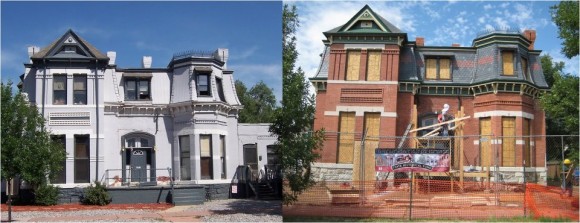History of the Mansion
The Mathews-Gotthelf Mansion is a two-story Second Empire style building and contributes to both the Curtis Park National Register Historic District and the Denver Landmark District, which is made up of over 500 homes. The Curtis Park neighborhood has a rich history, beginning with the introduction of the railroad into Denver. Curtis Park’s wide and tree-lined streets were an easy fit for the city’s first horse-drawn streetcar, making the neighborhood Denver’s initial streetcar suburb. The large homes of Curtis Park were all built between the 1880s and1890s. During this time, the prosperous merchants of the new city quickly developed the area, establishing a period of significance for the neighborhood and the Mathews-Gotthelf Mansion.
In 1880, James F. Mathews, a prosperous ore and bullion dealer, built the Mansion on the prominent corner lot at 26th and Champa Streets. The original house consisted of 5,000 square feet and occupied three lots. Mathews and his wife were socially prominent members of early Denver society. In 1890, Isaac Gotthelf purchased the house for $25,000. Gotthelf made his fortune from a mercantile in the San Luis Valley, cattle ranching, and banking interests. He was elected to the Colorado House of Representatives for the first General Assembly in 1876 and also served in the second General Assembly. Isaac Gotthelf died in 1910, and in 1915 his widow and four children sold the Mansion and moved back to the San Luis Valley. As early as the Silver Crash of 1893, the Curtis Park neighborhood began to deteriorate. Similarly, after 1915, the Mansion began to deteriorate as it cycled through various owners and was eventually divided into ten apartment units. Today the area is experiencing a renaissance, and dedicated residents are slowly restoring the neighborhood to its early grandeur. To aid the community’s revitalization efforts, and to prevent the loss of this significant historic resource, Colorado Preservation, Inc. purchased the house in 2007 with the intent to restore the Mansion to its period of significance (1880-1890s). Without this intervention, the building would have continued to fall into disrepair.
Project Description
Voted “Best Rehab Project” by Denver’s Westword magazine in March 2009, CPI’s involvement in the rescue of the historic Mathews-Gotthelf Mansion resulted in a critically needed stabilization/rescue of a neglected historic mansion in Denver’s Curtis Park historic district.
Back story: Colorado Preservation Inc. purchased the Mathews-Gotthelf Mansion in 2007 with the intent to restore its exterior and resell the property to a developer skilled in rehabilitation/reuse projects. A serious downturn in Denver’s housing market due to the 2008 recession altered – but did not derail – CPI’s plans to rescue the mansion. CPI formed a limited liability company (LLC) in conjunction with a private developer with the intent of utilizing state and federal historic tax credits to assist in the redevelopment costs. CPI held a volunteer work day in August 2010 to “deconstruct” some of the interior alterations, and then had the Mansion open for a very successful Doors Open Denver event that hosted nearly 400 visitors. Rehabilitation work included:
- Reconstruction the original front porch and south side door overhang
- Repair and restoration of the iron finials, windows and doors.
- Removal of all exterior paint and repainting
- Restoration of exterior masonry
- Reconstruction of the wood cornice and mansard slate roof
- Removal of the north annex, a later addition built in 1920
- landscape improvements
In 2014, CPI transferred ownership to a developer/contractor and arranged for a preservation easement agreement protecting the mansion’s exterior to be held in perpetuity by our local partners, Historic Denver, Inc.
Lessons learned: The Mathews-Gotthelf Mansion multi-phase project serves to illustrate how historic preservation, historic rehabilitation tax credit syndication, and a public/private partnership can make economic sense and revitalize historic neighborhoods such as Curtis Park, one of the oldest neighborhoods in Denver.
Project Support
This received support from the State Historical Fund, the Curtis Park Neighbors, Historic Denver, Inc., the City and County of Denver, the Colorado Historical Foundation, and Colorado Preservation, Inc.




